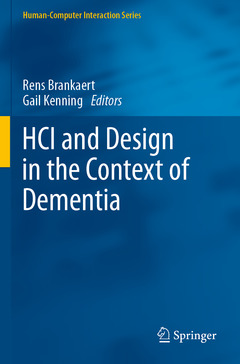Description
HCI and Design in the Context of Dementia, 1st ed. 2020
Human–Computer Interaction Series
Coordinators: Brankaert Rens, Kenning Gail
Language: English
Subjects for HCI and Design in the Context of Dementia:
Keywords
Publication date: 07-2021
355 p. · 15.5x23.5 cm · Paperback
Publication date: 07-2020
355 p. · 15.5x23.5 cm · Hardback
Description
/li>Contents
/li>Comment
/li>
Old age is currently the greatest risk factor for developing dementia. Since older people make up a larger portion of the population than ever before, the resulting increase in the incidence of dementia presents a major challenge for society. Dementia is complex and multifaceted and impacts not only the person with the diagnosis but also those caring for them and society as a whole.
Human-Computer Interaction (HCI) design and development are pivotal in enabling people with dementia to live well and be supported in the communities around them. HCI is increasingly addressing the need for inclusivity and accessibility in the design and development of new technologies, interfaces, systems, services, and tools. Using interdisciplinary approaches HCI engages with the complexities and ?messiness? of real-world design spaces to provide novel perspectives and new ways of addressing the challenge of dementia and multi-stakeholder needs.
HCI and Design in the Context of Dementia brings together the work of international experts, designers and researchers working across disciplines. It provides methodologies, methods and frameworks, approaches to participatory engagement and case studies showing how technology can impact the lives of people living with dementia and those around them. It includes examples of how to conduct dementia research and design in-context in the field of HCI, ethically and effectively and how these issues transcend the design space of dementia to inform HCI design and technology development more broadly. The book is valuable for and aimed at designers, researchers, scholars and caregivers that work with vulnerable groups like people with dementia, and those directly impacted.
Presents advances in the context of understanding how to design for people living with dementia and other similar conditions
Brings together the insights, understanding and achievements of experts in design for dementia in HCI
Provides concrete examples of successful projects, methods and approaches that can be used in the context of design for people with dementia
Foregrounds participatory and inclusive approaches to ensure full consideration is given to the users in design and research
These books may interest you

Dementia: The BasicsThe Basics 117.69 €

Dementia: The BasicsThe Basics 23.94 €


